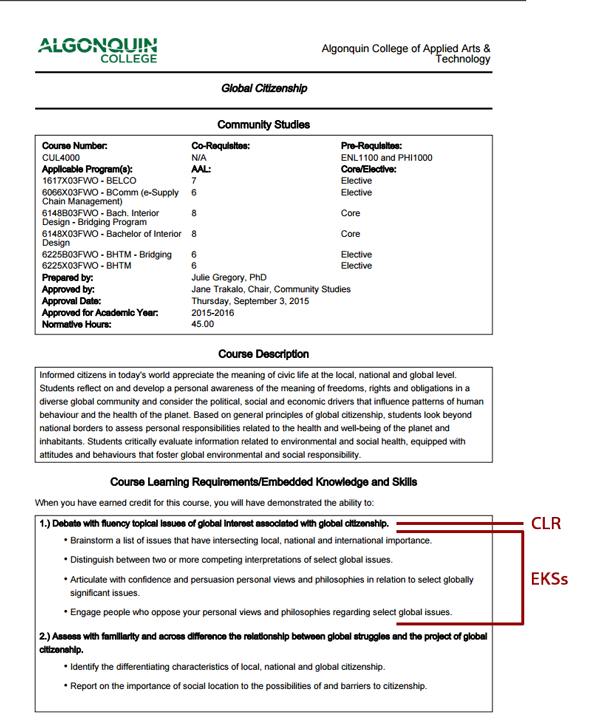What Are Learning Outcomes?
Learning outcomes are statements of what a learner is expected to know, understand and/or be able to demonstrate after completion of a process of learning. All aspects of teaching (activities, instructional content/media, and assessments) should be designed with outcomes in mind.
Course alignment begins by defining clearly the learning outcomes, such that both the students and faculty are aware of the essential knowledge and abilities that they should be able to demonstrate at the end of the course.
At Algonquin College, system-wide program standards have been created for a variety of programs leading to Ontario College Credentials:
- Vocational Learning Outcomes (VLO) / Essential Employability Skills Learning Outcomes (EES) (For programs leading to an Ontario College Certificate, Diploma or Advanced Diploma)
- Course Learning Requirements (CLRs)
- Embedded Knowledge and Skills (EKS)
Click on the following three sections to learn more about them.



Vocational Learning Outcomes
Vocational Learning Outcomes (VLOs) capture the learning that is being done at the program level. These are broader statements that include a variety of levels and experiences. The expectation is that this is what students will achieve by the end of the program. Employers, industry, and professional associations, and program graduates currently working in the field are all involved in the development and review process of VLOs.
If you are a course developer:
When designing or teaching a vocational course, the first thing you will want to do is review the list of Vocational Learning Outcomes for your program. This information is available in the approved program proposal documentation that your Chair or Academic Manager can provide you with. You must ensure that your new course validates at least one of your program’s vocational learning outcomes. Most program coordinators will have a list of the vocational learning outcomes for their program or you can refer to the program’s website.
Visit the Program Development website for more information on Vocational Learning Outcomes.
Essential Employability Skills (EES)
For programs leading to an Ontario College Certificate, Diploma or Advanced Diploma, the Essential Employability Skills (EES) Learning Outcomes are the second component of the program learning outcomes.
There are 11 EES Learning Outcomes that need to be demonstrated by graduates of programs leading to an Ontario college credential. They are listed below:
Graduates will have reliably demonstrated the ability to:
- Communicate clearly, concisely and correctly in the written, spoken, and visual form that fulfills the purpose and meets the needs of the audience.
- Respond to written, spoken, or visual messages in a manner that ensures effective communication.
- Execute mathematical operations accurately.
- Apply a systematic approach to solve problems.
- Use a variety of thinking skills to anticipate and solve problems.
- Locate, select, organize, and document information using appropriate technology and information systems.
- Analyze, evaluate and apply relevant information from a variety of sources.
- Show respect for the diverse opinions, values, belief systems, and contributions of others.
- Interact with others in groups or teams in ways that contribute to effective working relationships and the achievement of goals.
- Manage the use of time and other resources to complete projects
- Take responsibility for one’s own actions, decisions, and consequences.
If you are a course developer:
You can refer to the EES website to find more information about these essential employability skills.
Course Learning Requirements (CLRs)
A Course Learning Requirement (CLR) is a single-sentence statement that describes learning that integrates knowledge, skills, and attitudes that learners achieve by the end of a specific course. These statements identify the performances that must be demonstrated and verified in order to receive credit for a course. They should relate back to the overarching VLOs or the EES connected to that program.
Characteristics of CLRs
The following list describes the characteristics of strong CLRs:
- describe essential and measurable learning
- are clearly stated and realistic
- are performance based and start with active verbs
- promote integrated learning
- describe the objectives of the course
- are transferable to a variety of work contexts
- are verifiable through a variety of assessment techniques
- support one or more program outcome(s)

CLR examples:
- Debate with fluency topical issues of global interest associated with global citizenship.
- Assess with familiarity and across difference the relationship between global struggles and the project of global citizenship.
Algonquin College, Course: Global Citizenship, CUL400, 2015-2016
Embedded Knowledge and Skills (EKS)
EKS describe “stepping stones” to, or subsets of, the Course Learning Requirements (CLR). EKS statements encompass smaller learning segments than CLRs.
You may consider using Bloom’s Taxonomy of Learning to create the CLRs and EKSs.
EKS Examples:
- Brainstorm a list of issues that have intersecting local, national and international importance.
- Distinguish between two or more competing interpretations of select global issues.
- Articulate with confidence and persuasion personal views and philosophies in relation to select globally significant issues.
- Engage people who oppose your personal views and philosophies regarding select global issues.
Algonquin College, Course: Global Citizenship, CUL400, 2015-2016